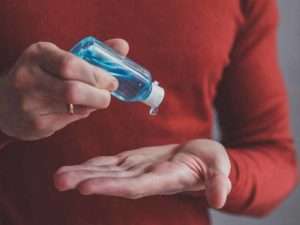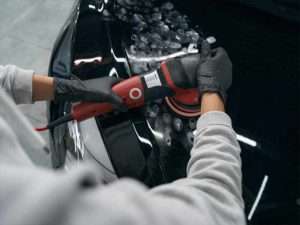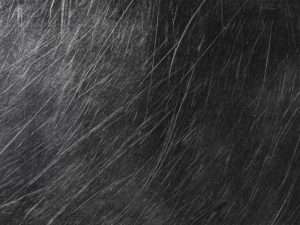Table of Contents
Do you have something stuck to your car paint and also happen to have some WD-40 on hand? You’re in luck since WD-40 has been promoted as a wonder solution for lots of odd jobs, especially with removing contaminants from car paint.
Yes, WD-40 is safe for use on car paint for short periods, but that doesn’t mean it’s the best idea. In this article, we’ll cover the common suggestions put forth on the Internet for how to use WD-40 to deal with paint issues.
Continue reading to learn more about the pros and cons of using WD-40 for some common car detailing tasks.
WD-40 On Car Paint
WD-40 is a versatile product that is safe to use on car paint to clean away bugs, tar, overspray, water spots, and more. That said, it isn’t the best tool for these jobs, although it will work in a pinch. There are products that are more effective for working on your car’s finish.
Is WD-40 Safe on Auto Paint?
WD-40 is made from many ingredients that can damage your car’s paint on their own. For example, a component that is similar to kerosene can affect a clear coat in days. However, the proprietary blend of ingredients makes it safe to use on vehicle paint or clear coat. Still, WD-40 is not a good thing to put on car paint, as explained later.
How Do You Use WD40 on Car Paint?
When trying to remove contaminants from your vehicle’s paint, you should spray WD-40 onto a clean cloth and then wipe the cloth with WD-40 applied to the area you want to clean. Spraying it onto a rag instead of your paint will keep WD-40 from getting onto unintended surfaces or running into places you don’t want it getting on or into.
What you do next depends on what you’re dealing with:
- Sticky substances, such as sap from trees and bird droppings, can dig into the finish and become difficult to remove if left to harden. If you’re trying to get rid of bugs, tar, or gum, leave the WD-40 to soak for 10 minutes or so. If you have a large wad of gum, you can use the smart-straw version to drip WD-40 under the gum.
- Wipe the WD-40 and remaining residue away using a soft cloth.
- If you have oil splatters or other liquid material on the car that can’t be dissolved by water, wipe it immediately. As a degreaser, WD-40 works well and instantly in these cases.
How Do You Remove Unwanted Paint from Your Car with WD-40?
Among the ways that unwanted paint can appear on your vehicle are as a transfer (scuff) from a car that hits you, through vandalism with a spray can, or overspray on components when you’re painting something while near your vehicle.
It’s best to try and remove the paint as quickly as possible because once it hardens, it can bind to the car surface and prove challenging to remove. Try the following steps:
- Apply the WD-40 with a rag to the paint. You may have to leave it on for five minutes or so to allow it to begin to penetrate.
- Soak a magic eraser in warm water and squeeze out the excess liquid.
- Repeat these steps as needed to remove the paint completely.
- Using the magic eraser, lightly wipe to remove the paint, but don’t scrub so hard that you begin to affect your vehicle’s clear coat.
Can You Effectively Use WD-40 on Car Paint?
The WD-40 brand consists of many different products that lubricate, degrease, or remove rust. The one you’re most probably familiar with is the original Multi-Use Product which is the product that defined the brand name. WD comes from Water Displacement, and 40 is the number of formulas tried before the developers found the right mix.
Because it is typically found in your garage, WD-40 can be a handy solution to reach for when you need to clean your car or truck. But is it effective and safe to use WD-40 on your car’s paint? Will it damage the finish? And are there better solutions?
What Else Can I Use Instead Of WD-40
Citrus-Based Degreaser
Citrol 266 Degreaser
Citrol 266 is a surprisingly powerful degreaser that is more effective at removing things like bugs and tar from car paint than most purpose-designed products
Adhesive Remover
Goo Gone Automotive
Goo Gone Automotive is a clear coat-safe adhesive remover that can even remove paint from the surface of your car’s finish. It’s smart to have on hand as a detailer.
Water Spot Remover
Meguiar’s Water Spot Remover
Water spots can happen from rain, sprinklers, or not drying your car before the sun dries up those water beads on your paint’s surface. This is the best solution.
What Does WD-40 Do?
WD-40 goes into nooks and crannies and penetrates stuck parts to do the following.
- Lubricate moving parts such as gears, wheels, hinges, chains, and rollers.
- Break up rust and corrosion, so parts move more freely.
- Act as a protective coating against anything the causes rust and corrosion.
- Displace moisture to dry electrical circuits.
- Remove grease, gum, sap, tar, super glue, adhesives, and other sticky substances from all surfaces.
Can You Remove Car Scratches with WD-40?
No, but depending on how shallow or small the scratch is on your car paint, you may be able to hide them temporarily with WD-40 as follows:
- Apply WD-40 generously on the scratches and leave it for a minute or so.
- With a soft cloth, such as All-Purpose Microfiber Terry Cleaning Towel, wipe the WD-40 firmly in the direction of the scratches to work it in.
- Repeat as needed.
This procedure only works with minor cosmetic scratches that affect the clear coat only. It will not eliminate scratches that go into the metal of your vehicle. But even on deep gouges, WD-40 can temporarily prevent water from working its way onto the bare metal to produce rust.
WD-40 does not act as a permanent solution for all blemishes since it only temporarily covers scratches and does not remove them. When the WD-40 is washed off, the scratches appear again.
Can WD-40 Remove Dirt and Water Spots?
To remove dirt stains and water spots from your car or truck, apply WD-40 on the stained area and wipe it away with a soft cloth. This method also works for water stains on windows and mirrors.
Can You Remove Bumper Stickers With WD-40?
Yep. WD-40 will break down the bumper sticker adhesive and allow you to get your bumper clean without any adhesive residue.
You’ll still likely need something to help you peel away the sticker. My recommendation here is to use a plastic razor blade. Plastic razor blades are very handy for all sorts of car detailing projects and much safer than a real razor blade. Not only will you not cut yourself with a plastic razor blade but you’ll be far less likely to damage your paintwork.
I don’t recommend WD-40 for this job but it will work. A better product to use would be Citrol 266 or Goo Gone. These are far more appropriate and effective for breaking down adhesives and safer for your clear coat.
Can You Polish a Car with WD-40?
The ingredients of WD-40 include paraffin, which can make car paint shine and make faded paint look better. If you spray WD-40 on top of a vehicle covered in a clear coat, it can make car paint shine, similar to the effect you get from car wax. In addition, WD-40 makes unprotected paint surfaces more resistant to moisture. If you spray it on the surface of your vehicle, you can help prevent tree sap, bird droppings, tar, and insects from sticking to the paint. Water will also bead more readily.Why Shouldn't You Use WD-40 on Car Paint?
WD-40 was formulated for vehicles specifically to penetrate and loosen rusted and corroded nuts, bolts, and other fasteners. Although some car owners swear by its use for cleaning painted vehicle surfaces, there are two reasons you shouldn’t:
- WD-40 contains oils that collect dirt, dust, and other debris. If even a trace of this substance sits in a crack, joint, or scratch on your vehicle, it will become dirty. And that dirt can only be cleaned in a specific way, as explained later.
- More effective solutions exist for cleaning dirt off your car, polishing it, and protecting it, also described later. These solutions do the job better than WD-40 and suffer none of its ill effects.
How Do You Remove WD-40 from Car Paint?
If you want to remove WD-40 from your vehicle, you can’t use plain soap and water. Instead, you’ll need an automotive detergent car shampoo, also known as prep or wax-stripping shampoo. Its potent pH formula penetrates the oils in WD-40 and car wax.
Leave the shampoo on for a few minutes to break down the WD-40 and any dirt it contains. Then rinse the vehicle to eliminate any residue and use a soft cloth to dry. Be especially thorough on the windows, or you may leave streaks.
What Is More Effective on Car Paint?
DetailDIY contains many posts that describe better solutions for issues with car paint.
Removing Dirt from Car Paint
- For information on removing tree sap and insect droppings from your car, check out How to Remove Hardened Tree Sap from Car Paint and Glass. We recommend applying a degreaser like Citrol 266, letting it soak into the sap for 30 seconds, and then using a microfiber rag to wipe it away.
- For removing bug bits, which can be acidic enough to damage your paint, we recommend the same technique with Citrol 266. This technique is detailed in How to Remove Bugs from Car without Damaging Paint.
- An option to consider as an alternative is using a mix of 50 percent vinegar, and 50 percent distilled water to eliminate water spots, among other methods. These are detailed in How To Remove Water Spots From Car Paint.
- To remove paint scuffs, apply a solvent like Goof Off using a microfiber rag and wipe away the transferred color. Some scrubbing may be necessary, but you don’t have to worry that you’ll damage your original paintwork because this solvent is gentle. For more information, see How To Remove Paint Scuffs From Car Paint.
Making the Surface Look Good
- If you have scratches, use a high-quality touch-up paint repair kit from PaintScratch.com. The kit will match your vehicle’s exact paint color, and you can use the pen to eliminate the scratch. The kit shows you how to smooth out the touch-up and protect it with the included clear coat. This touch-up kit is detailed in How To Apply Touch Up Paint To Car Scratches And Stone Chips.
- If done correctly, polishing a car to improve its appearance is a multi-step process, as shown in How To Make A Car Shine Like Glass. It involves washing your vehicle, drying with safe methods, decontaminating the paint, correcting paint problems, and coating the resulting finish for protection.
- You have three options for protecting the paint on your vehicle.
- A paint sealant like Wolfgang Concours Series Deep Gloss Paint Sealant is inexpensive and easy to use.
- A ceramic coat like Adam’s UV Ceramic Paint lasts for years and offers mild scratch protection but is more expensive.
- Paint Protection Film can deflect rocks from your car with no damage, self-heals light scratches, and needs little maintenance. But it requires costly professional installation. An excellent choice is VViViD 3M Scotchgard Paint Protection Film.
- For more details, look at Best Car Paint Protection.
Conclusion
WD-40 is generally harmless to car paint and clear coat and is used by many owners to clean and polish up their vehicles. However, this product was never formulated to be used in those capacities. It contains oils that can attract dirt, so it can dirty the surface if it remains in crevices.
There are far more effective products for cleaning, such as Citrol 266, eliminating scratches such as with a kit from PaintScratch.com, and protecting the paint with a product such as Adam’s UV Ceramic Paint Coating. The methods for using these products are detailed in the posts of this blog.
If you have any questions or comments, please let us know.















